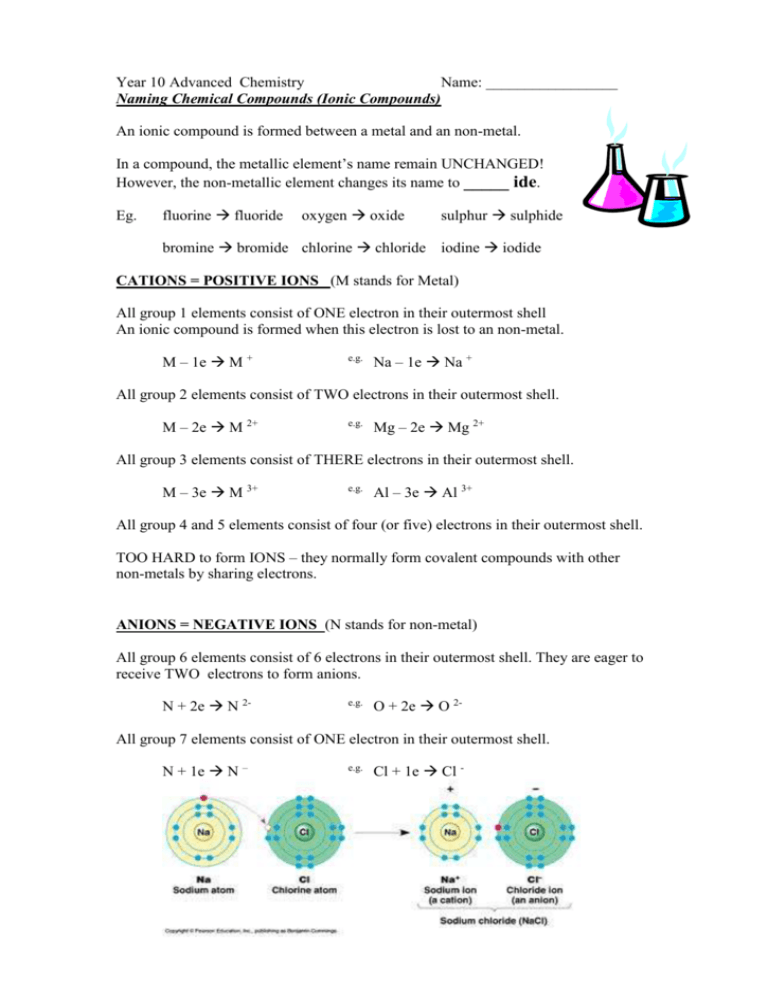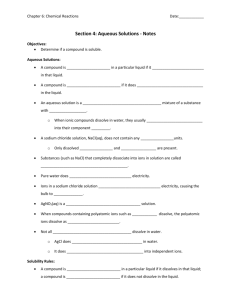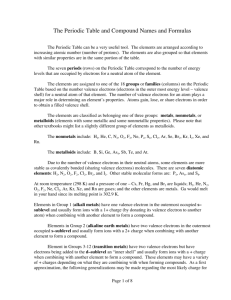Naming Chemical Compounds (Ionic Compounds)
advertisement

Year 10 Advanced Chemistry Name: _________________ Naming Chemical Compounds (Ionic Compounds) An ionic compound is formed between a metal and an non-metal. In a compound, the metallic element’s name remain UNCHANGED! However, the non-metallic element changes its name to _____ ide. Eg. fluorine fluoride oxygen oxide sulphur sulphide bromine bromide chlorine chloride iodine iodide CATIONS = POSITIVE IONS (M stands for Metal) All group 1 elements consist of ONE electron in their outermost shell An ionic compound is formed when this electron is lost to an non-metal. M – 1e M + e.g. Na – 1e Na + All group 2 elements consist of TWO electrons in their outermost shell. M – 2e M 2+ e.g. Mg – 2e Mg 2+ All group 3 elements consist of THERE electrons in their outermost shell. M – 3e M 3+ e.g. Al – 3e Al 3+ All group 4 and 5 elements consist of four (or five) electrons in their outermost shell. TOO HARD to form IONS – they normally form covalent compounds with other non-metals by sharing electrons. ANIONS = NEGATIVE IONS (N stands for non-metal) All group 6 elements consist of 6 electrons in their outermost shell. They are eager to receive TWO electrons to form anions. N + 2e N 2- e.g. O + 2e O 2- All group 7 elements consist of ONE electron in their outermost shell. N + 1e N – e.g. Cl + 1e Cl - Year 10 Chemistry – Naming compounds and writing formulae Name: ________________ Exercise A - Name these compound. Name: ___________________ 1. NaCl ________________________ 2. KI _________________________ 3. MgO ________________________ 4. AlF3 ________________________ 5. LiBr ________________________ 6. CaO ________________________ 7. K2S ________________________ 8. FeS ________________________ 9. CuC12 ________________________ 10. ZnBr2 ________________________ Radicals or Polyatomic ions are ions formed from different types of non-metals chemically combined together with an overall net charge. There are 7 common radicals. (many end with –ate) 2Carbonate CO3 Bicarbonate HCO3 Sulphate SO4 2- Nitrate NO3 - Phosphate PO4 3- Hydroxide OH - Ammonium NH4 + (the only positive radical you need to know) Exercise B - Name these compound. 1. KOH ________________________ 2. NH4I _________________________ 3. MgSO4 ________________________ 4. Al2O3 ________________________ 5. AgNO3 ________________________ 6. Ba(OH) 2 _____________________ 7. (NH4)3PO4 ______________________ 8. NaHCO3 ______________________ 9. CuSO4 ________________________ 10. PbCO3 ________________________ Exercise C – Give the chemical formulae of these compounds. Compound Name Sodium Bromide Magnesium Sulphide Calcium Carbonate Lithium Sulphate Ammonium Hydroxide Aluminium Nitrate Aluminium Oxide Cation Anion Chemical Formula Exercise D - More Practice on Naming compounds and writing chemical formulae. 1+ 2+ 3+ 1- 2- 3- Li+, Na+, K+, Ag+, Cu+ Mg2+, Ca2+, Ba2+, Sr2+, Fe2+, Zn2+, Cu2+, Ni2+ Pb2+ Al3+, Fe3+ Cl-, Br-, I-, O2-, S2- N3- NH4+ P3OH-, HCO3- CO32-, SO42- PO43- NO3Formula Name Name Formula KCl Silver Bromide NaBr Lead Iodide K2O Stronium Chloride MgS Iron (II) Hydroxide ZnCl2 Copper (I) Oxide KOH Ammonium Nitrate Ca SO4 Barium Sulphate Al PO4 Magnesium Phosphate NaHCO3 Ammonium Carbonate Exercise E - Make up another 12 compounds that were not mentioned above. Formula Name Formula Name Well done! If you have mostly correct……. Ready to study VCE Chemistry








